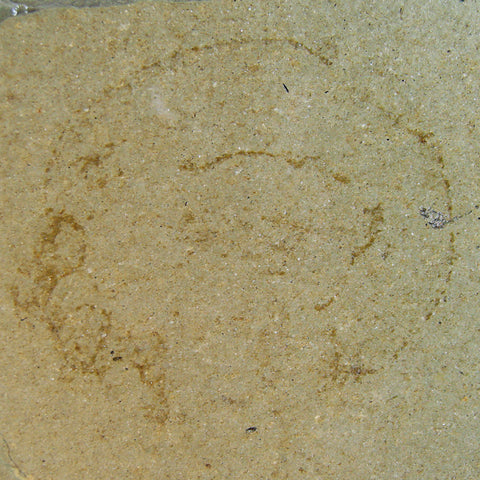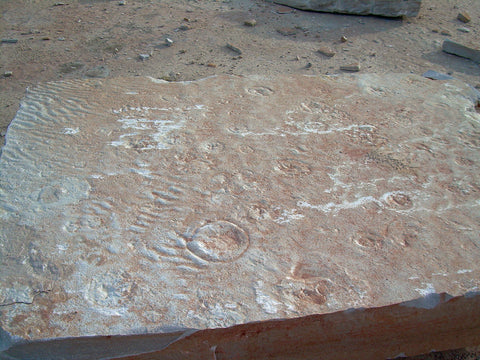Fossil Jellyfish
Posted by David Penney on
Fossil jellyfish are exceptionally rare, particularly where they are preserved in mass stranding event settings and it is not hard to imagine why. Who would ever expect such soft-bodied organisms to leave identifiable traces of their existence in the fossil record?
Stranded jellyfish on the tidal flats of the Gwendraeth estuary at Carmarthen Bay, Wales (July 2016)
Two of our titles consider these remarkable fossils and the following accounts are taken (in slightly abbreviated form, including references removed for brevity) from those books (click the covers to go to the product page to find out more information about the title or to order a copy).
 During the excavations in the years 2005–2007 several greenish blotches were found on the surface of the laminated sequences of the diatomaceous carbonate siltstone. At first, we devoted no attention to these structures. Later, however, two very distinct greenish blotches with very clear and well-defined inner structures were found, indicating that these were in fact fossils. A close inspection soon revealed that these were jellyfish fossils. Except for one probable impression specimen the fossils of medusae from the Coprolitic Horizon are two-dimensional compressed fossils. Only a thin film of organic material, that built the soft body of these medusae (next to the >95% of water) is preserved. One of the specimens still clearly shows symmetry similar to that of the original animal; the umbrella, the tentacle-like arms that surrounded the mouth, and some barely observable tentacles. In the case of the second, larger specimen, however, only fragments of the living animal are preserved. The preserved structures are believed to be the edge of the umbrella with a clearly visible canal system.
During the excavations in the years 2005–2007 several greenish blotches were found on the surface of the laminated sequences of the diatomaceous carbonate siltstone. At first, we devoted no attention to these structures. Later, however, two very distinct greenish blotches with very clear and well-defined inner structures were found, indicating that these were in fact fossils. A close inspection soon revealed that these were jellyfish fossils. Except for one probable impression specimen the fossils of medusae from the Coprolitic Horizon are two-dimensional compressed fossils. Only a thin film of organic material, that built the soft body of these medusae (next to the >95% of water) is preserved. One of the specimens still clearly shows symmetry similar to that of the original animal; the umbrella, the tentacle-like arms that surrounded the mouth, and some barely observable tentacles. In the case of the second, larger specimen, however, only fragments of the living animal are preserved. The preserved structures are believed to be the edge of the umbrella with a clearly visible canal system.
Jellyfish can often be seen floating at the surface of the sea, often in large groups that form brightly coloured patches on the water. They swim by rhythmic movements of the umbrella. All extant species are marine, being found in both tropical and temperate waters around the world. After storms, large numbers of them can be found washed up on beaches. On land, they become helpless masses of jelly, unable to move, and they soon dry out and die.
Fossilized impressions of scyphomedusae are exceptionally rare. Fossilized mass-stranding events of scyphomedusae are even more rare. One of the most important localities, where thousands of fossil jellyfish impressions (including the largest jellyfish known in the geological record) have been found, is the Late Cambrian Mt. Simon-Wonewoc Sandstone in central Wisconsin. These beds contain at least seven horizons characterized by hundreds of decimetre-sized impressions of medusae; these represent one of only two fossilized mass-stranding deposits. The other fossil site is in New Brunswick, Canada. Several scyphomedusae have been found also in the Late Ordovician beds of the Stonewall Formation in central Manitoba, Canada and in the Late Jurasic Solnhofen Limestone of Bavaria, Germany.
With the exception of chondrophorine hydrozoans, most cnidarian medusae are difficult to preserve because they have no durable parts. When stranded or buried, rapid decay processes and intense physical and biological reworking inhibit preservation of their soft tissues, especially in coarse-grained marginal marine settings where they are typically stranded. If jellyfish are washed up on the beach, they are very likely going to be scavenged by terrestrial organisms (birds) or other marine animals that are turning up the sediments, for example sand crabs. Thus, to bury and preserve a jellyfish in the fossil record requires unique conditions in which there are few terrestrial scavengers and few burrowing organisms to disturb buried carcasses. These conditions occurred when the beds of the Coprolitic Horizon were deposited. In fine-grained settings, where catastrophic burial and stagnation inhibit reworking (e.g. Konservat-Lagerstätten), isolated medusae are only rarely preserved.

Miocene fossil medusa from the Tunjice Hills, Slovenia, approx. 4 cm diameter
 Around 2000, a paleontologist and fossil dealer named Dan Damrow and several other paleontologists began discussions about some interesting fossils. Damrow had found them while scouting the Cambrian sandstone outcrops near his home in central Wisconsin. This was Blackberry Hill country. It was known that Climactichnites and Protichnites were found there, and it was suspected that the rock was deposited in tidal flats similar to those in the Potsdam of Quebec. He noticed that these outcrops, with one in particular, were especially rich in trackways, and a few of them had something else to add to the attraction as well. On the surfaces of certain layers were groups of low, circular mounds, ranging in size from a few centimeters to greater than 0.5 m in diameter. In some areas, hundreds of these mysterious objects dotted the landscape. A certain regularity of their shapes and structures suggested to Damrow that these were fossils. The only other Cambrian fossils having a remotely similar appearance are stromatolites, which could be ruled out due to the new fossils’ apparent lack of laminations. Whatever these fossils were, Damrow knew that they must be significant, and needed to be brought to the attention of the scientific community.
Around 2000, a paleontologist and fossil dealer named Dan Damrow and several other paleontologists began discussions about some interesting fossils. Damrow had found them while scouting the Cambrian sandstone outcrops near his home in central Wisconsin. This was Blackberry Hill country. It was known that Climactichnites and Protichnites were found there, and it was suspected that the rock was deposited in tidal flats similar to those in the Potsdam of Quebec. He noticed that these outcrops, with one in particular, were especially rich in trackways, and a few of them had something else to add to the attraction as well. On the surfaces of certain layers were groups of low, circular mounds, ranging in size from a few centimeters to greater than 0.5 m in diameter. In some areas, hundreds of these mysterious objects dotted the landscape. A certain regularity of their shapes and structures suggested to Damrow that these were fossils. The only other Cambrian fossils having a remotely similar appearance are stromatolites, which could be ruled out due to the new fossils’ apparent lack of laminations. Whatever these fossils were, Damrow knew that they must be significant, and needed to be brought to the attention of the scientific community.
Among those involved in the early conversations were Ellis Yochelson, of the National Museum of Natural History, Jere Lipps, then of the University of California – Berkeley, and James Hagadorn, then of the California Institute of Technology. Each person had a special interest in the fossils due to relevance to their current research. Within a few years, each of those paleontologists, in addition to Robert Dott of the University of Wisconsin – Madison, had visited the outcrops where those fossils were found. The prevailing conclusion was that these peculiar circular fossils were scyphozoans (i.e. a type of jellyfish abundantly inhabiting today’s oceans) and their occurrence in large groups represented mass strandings on an ancient tidal flat. Hagadorn carried out extensive studies on the material. The new data further indicated that these abundant discoidal fossils were in fact scyphozoans. In 2002 Hagadorn, Dott and Damrow made the announcement in Geology. This was a huge discovery that immediately put Blackberry Hill on the proverbial map. Consisting mostly of water, scyphozoans rarely fossilize. Of further interest was that never before had so many fossilized scyphozoans or layers of strandings been found in one locality, and never had scyphozoan fossils attained such a large size. Graham Young and Hagadorn published a study in 2010 that listed this locality as producing over 10,000 specimens of 50–950 mm diameter scyphozoans from over nineteen horizons. The discovery was covered in numerous journals, science and nature magazines, and other media. Lisa-ann Gershwin begins page 1 of her book, Stung!—On Jellyfish Blooms and the Future of the Ocean, with an account of the Blackberry Hill scyphozoan strandings.
Within a few short years, Blackberry Hill had the attention of the world’s Earth scientists. They knew that something very special was going on there. A place capable of such remarkable preservation, and being located in a Cambrian tidal flat known to have abundant trace fossils, including Climactichnites, Diplichnites and Protichnites, might finally bring closure (if there is such a thing as closure in science) to solving the mystery of the first animal life on land.

Our field team (for scale) with a stranded jellyfish at Carmarthen Bay, Wales
Our field team showing the density of stranded individuals
Share this post
- 0 comment
- Tags: Comment, Monograph series
0 comment



